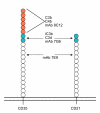Complement and humoral immunity
- PMID: 19388161
- PMCID: PMC4018718
- DOI: 10.1016/j.vaccine.2008.11.022
Complement and humoral immunity
Abstract
The complement system was discovered almost a century ago as an important effector in antibody-dependent killing of microorganisms. Since this early period much was learned aboutthe biochemistry and structure of complement proteins and their function in mediating inflammation. More recently, a prominent role for complement was identified in linkage of innate and adaptive immunity. In this review, I will discuss our current understanding of the importance of complement in enhancing the humoral immune response to both model antigens and pathogens. As discussed below, it is evident that the complement system participates in marking of "foreign" pathogens and "presenting" them to B cells in a manner that enhances both antibody production and long-term memory. In this special issue of Vaccine, we see examples of how complement is critical in the immune response to bacterial and viral pathogens. Moreover, the finding that most organisms have co-evolved proteins to evade complement detection underscores its importance in host protection.
Figures




References
-
- Bordet J, Gengou O. Sur l’existence de substances sensibilisatrices dans la plupart des serum antimicrobiens. Annal Inst Pasteur. 1901;15:289–302.
-
- Reid KBM, Porter RR. The proteolytic activation systems of complement. Annu Rev Biochem. 1981;50:433–64. - PubMed
-
- Nussenzweig V, Bianco C, Dukor P, Eden A. Receptors for C3 on B lymphocytes: possible role in the immune response. Academic Press; New York: 1971.
-
- Pepys MB. Role of complement in induction of the allergic response. Nature:New Biology. 1972;237:157–9. - PubMed
-
- Jackson CG, Ochs HD, Wedgewood RJ. Immune response of a patient with deficiency of the fourth component of complement and systemic lupus erythematosus. N Engl J Med. 1979;300:1124–9. - PubMed
Publication types
MeSH terms
Substances
Grants and funding
LinkOut - more resources
Full Text Sources
Research Materials

